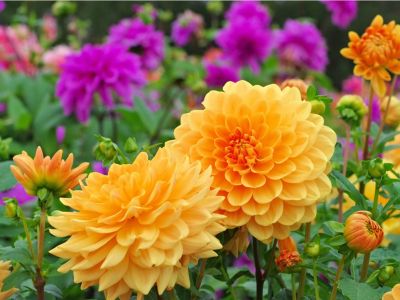How to Plant Dahlia Tubers
If you’re sure there will be no more frosty nights in early spring, it’s safe to get your dahlia tubers into the ground. If you’re wrong about the frost, you could lose or damage them. Plan to grow your dahlias in a spot where they’ll receive full sun and be sure the soil is very well draining. Tubers that sit in wet soil tend to become mushy and rot, and dahlias are no exception. Each healthy tuber should have at least one eye. You will want to sink some sturdy support stakes into the ground before planting your tubers. 6 foot (2 m.) stakes sunken a foot (31 cm.) into the ground is recommended. Putting in stakes first will keep you from accidentally damaging the tubers later when your growing plants need to be supported, and they will definitely need support. Next to the stakes, dig your planting holes 6 to 8 inches (15-20 cm.) deep for tall varieties and 2 to 3 inches (5-8 cm.) deep for shorter varieties. Make sure your tubers are spaced 18 to 24 inches (46-61 cm.) apart. Another method of planting dahlias is to dig a 6 to 8 inch (15-20 cm.) deep trench, spacing the tubers again, 18 to 24 inches (46-61 cm.) apart. Cover the trench with soil and a layer of mulch. When your planting holes or trenches are ready, place the dahlia tubers flat on their sides and cover with soil. Mulching over the top helps keep the weeds down, which your dahlias will appreciate. Keep in mind when growing dahlia flowers that they can reach heights from 1 to 5 feet (31 cm. to 1.5 m.) tall, so allowing plenty of space in between the tubers is important.
Dahlia Plant Care
Depending on how warm the soil is, your dahlias will take somewhere around six to eight weeks to sprout. They do better when the soil is 60 degrees F. (16 C.). When they get to be around a foot (31 cm.) high, there’s work to be done. It’s time to give your dahlias some special attention. Dahlia experts advise that only the one strongest shoot should be allowed to develop from each tuber. When the plant is 10 to 12 inches (25-31 cm.) high, gently pull the soil away from the tuber and remove the extra shoots, snipping them off right at the tuber. Cover the tuber again with soil. These extra shoots can be easily rooted for new plants. If you don’t take them off, your dahlias will not be as large and prolific. In addition, when your plants are at this height, carefully tie them loosely to the support stake with soft yarn, nylon stockings, or soft twine. At this stage, your plants will need an inch (2.5 cm.) of water every week throughout the growing season and double that if the weather is dry. Keep your dahlia bed weed free.
Planting Dahlias in Containers
The rules are the same. Make sure there’s 6 to 8 inches (15-20 cm.) of well-draining soil and use strong stakes. Mulch them. Trim when they are a foot (31 cm.) high and water them. When choosing a container for your dahlia, keep in mind how large these plants can grow and be sure you have a very large pot to support them.
Additional Dahlia Maintenance
After planting your dahlia tubers, encourage their roots by feeding them with a 10-10-10 fertilizer every few weeks. By the time they get to be around 15 inches (38 cm.) tall, pinch off their suckers to strengthen the plant. Keep the area around the dahlias free of weeds and prune away any broken stems. Healthy dahlias usually aren’t plagued by pests, but there are some that could show up. Thrips, snails, spider mites, earwigs, or grasshoppers may pay a visit, but be sure to treat them with insecticidal soap, neem oil, or a chemical free slug repellent. Natural predators like birds, frogs, and toads will help you control pests. Dahlias take a bit of attention and nurturing but they’re so stunning that they’re totally worth the effort.
